Don't wanna be here? Send us removal request.
Text
Immigration code of marine invertebrates
Let`s remember the importance of studying how well some larvae, such as Kina larvae, can travel in the sea. And also that, when they travel, they carry their genes to other populations, which will be more similar to the original population of these larvae (at least at the genetic level). This is a bit confusing, but in the end it means that when populations are more similar, they can exchange larvae, but when populations are different, they do not exchange many larvae and may even evolve in isolation if no larvae is exchanged at all.
It would be very nice if all the animals followed the same laws for immigration of larvae in the marine environment, and we would be able to study only one species to define a complete management and conservation plan for a whole region. However, as each species has particular traits and responds differently to its surrounding environment, it is not that simple. Actually, it is really very complex, and the only way to design a good management plan for a specific area is to study as many species as possible and try to understand which populations are similar and can be mixed, and which populations live in isolation and have to be individually protected. With that in mind, I put together a summary of all research on population connectivity of marine invertebrates from New Zealand that I could find, and it is possible that I have missed one or another. In the table below, when it is written that there are differences among populations, it means that these populations are not very well connected. If you look at the “Population Genetic Differentiation” column, you will find that some species show the same patterns, as the pattern “populations of the North Island are different from those of the South Island”. Can you think of what these repetitions mean? Post your thoughts at the www.seasciencing.tumblr.com and we follow up next week!

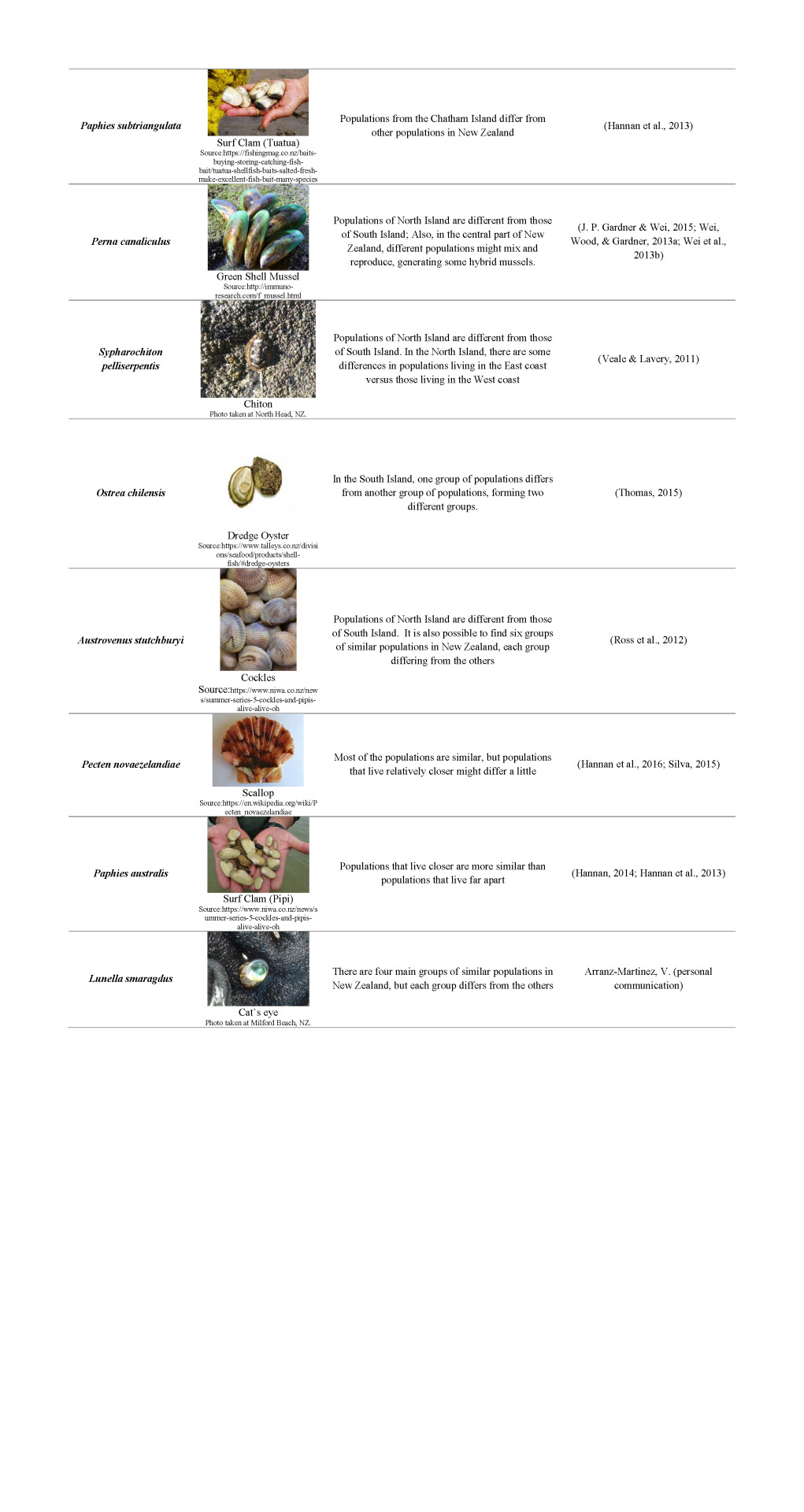
_______________________________
Leis de imigração dos invertebrados marinhos
Você se lembra da importância de estudar a distância que algumas larvas viajam no mar, como larvas do ouriço Kina? E que, quando viajam, essas larvas carregam seus genes para outras populações, tornando-as mais semelhantes à sua população original (pelo menos ao nível genético)? Isso é um pouco confuso, mas no fim significa que quando as populações são mais semelhantes, elas podem trocar larvas, mas quando as populações são diferentes, elas não trocam muitas larvas e podem até evoluir isoladamente se não houver troca alguma.
Seria muito bom se todos os animais seguissem as mesmas leis de imigração de larvas no ambiente marinho, e nós seríamos capazes de estudar apenas uma espécie para definir um plano completo de manejo e conservação de uma região toda. No entanto, como cada espécie tem características particulares e responde de forma diferente ao ambiente ao seu redor, não é tão simples assim. Na verdade, é realmente muito complexo e a única maneira de definir um bom plano de manejo para uma área específica é estudar tantas espécies quanto possível e tentar entender quais populações são semelhantes e podem ser misturadas e quais populações vivem isoladas e devem ser protegidas individualmente. Com isso em mente, eu fiz um resumo de todas as pesquisas sobre conectividade em populações de invertebrados marinhos da Nova Zelândia que eu consegui encontrar, e é possível que eu tenha deixado uma ou outra de fora. Na tabela abaixo, quando está escrito que há diferenças entre populações, significa que essas populações não se conectam muito bem. Se você olhar para a coluna "Diferenças genéticas entre populações", você vai descobrir que algumas espécies tem os mesmos padrões, como aquele em que as populações da Ilha do Norte são diferentes das populações da Ilha do Sul. Você imagina o que essas repetições significam? Poste suas ideias no www.seasciencing.tumblr.com e continuaremos com este assunto na próxima semana!

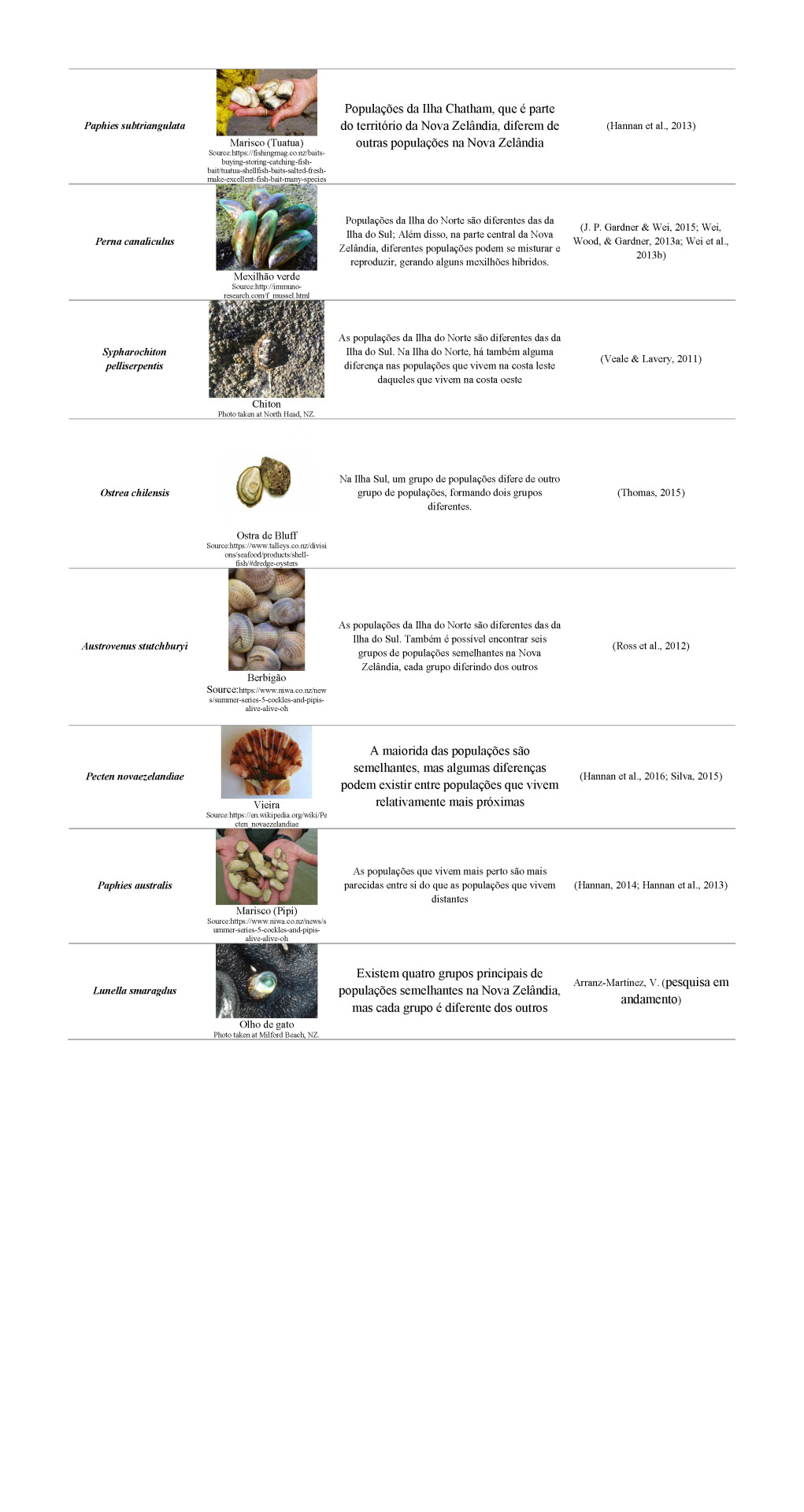
0 notes
Text
Why to study how far larvae travel in the sea?
Do you remember the travel plans of a sea urchin species called Kina, which I posted last week? With that post, we were left to think about the importance of studying how far Kina larvae can travel in New Zealand and if it is far enough to connect its populations living in North Island with those living in South Island, in a way that all its populations would have similar genes, which is not true for Kina, right?
The importance of understanding how larvae and adults from different species travel in the sea is directly linked to management of fishery resources and conservation of biodiversity. I will try to explain with a simple example: We know that Kina larvae cannot travel very well between North Island and South Island. Being extremist, this means that Kina from North Island do not mix genes with Kina from South Island, and that populations from each of the Islands is living and evolving separately. Imagine that the exploration of Kina in North Island is much more common than in South Island and that Kina in North Island start to disappear because of that. Everybody would expect that Kina from South Island would travel to the North Island and repopulate it. But if Kina cannot travel very well between Islands, then it would never be able to repopulate the North Island! Worse than that, as populations from both Islands are not completely connected, there is a possibility for them to be optimally adapted to the Island in which they live, which means that even if humans transported Kina larvae from South Island to North Island, Kina would die in the North Island because the environment is very different from the one it is adapted. This simple example helps us to understand that Kina populations from North and South Islands have to be managed separately, because in nature they are not very well connected.
It is straightforward to understand the importance of studies of population connectivity in species that are fished and eaten by people. But what about the other species? Do you remember when I said that Kina might be optimally adapted to its local environment? All species that live in the same environment of Kina are essential for keeping this environment the way it is. If something changes in the environment, Kina might die and we would lose Kina even without fishing it. It is true that a change in environment can be caused by many physical factors, such as a chemical contamination or even the rise of temperature caused by the global warming. But it can also be caused by the extinction of species that live in such environment, and in this case, it might not be effective to simply bring individuals from other populations to repopulate the extinct places, because of the same reasons that it would not be effective for Kina.
In the end, knowing how populations are connected in the sea is very important to preserve both the edible and not edible species, and also their environment. Nevertheless, each species has different traits and behaviour, so the more we understand about how their populations are connected, the better to make good preservation plans and ensure that you will have your much prized seafood for ever.
Just to finish, the sea is important for us because of many more reasons than only seafood. I used simple examples in this post just to illustrate the importance of researches such as the one done with Kina, and to justify why we still need many studies like this. I know you can think of many more reasons for that, and surely many more for the importance of the sea. I will leave this up to you, but feel free to start a discussion at the “sea questioning” in www.seasciencing.tumbrl.com.
Sea you soon!
_______________________
Por que estudar a distância que as larvas viajam no mar?
Você se lembra dos planos de viagem de uma espécie de ouriço-do-mar chamada Kina, que eu postei na semana passada? Aquele post nos fez pensar sobre a importância de estudar até que ponto as larvas de Kina podem viajar na Nova Zelândia e se elas viajam o suficiente para conectar as populações que vivem na Ilha Norte com as que vivem na Ilha Sul, de forma que todas as populações teriam genes semelhantes, o que não é verdade para Kina, certo?
A importância de compreender a capacidade de viajar no mar de larvas e adultos de diferentes animais está diretamente ligada à gestão de recursos pesqueiros e à conservação da biodiversidade. Vou tentar explicar com um exemplo simples: Sabemos que larvas de Kina não podem viajar muito bem entre a Ilha Norte e a Ilha Sul da Nova Zelândia. Sendo extremista, isso significa que Kinas da Ilha Norte não misturam genes com Kinas da Ilha Sul, e que as populações de cada uma das Ilhas vivem e evoluem separadamente. Imagine que a exploração de Kinas na Ilha Norte é muito mais comum do que na Ilha Sul e que os Kinas da Ilha do Norte começam a desaparecer por causa disso. Todo mundo esperaria que Kinas da Ilha Sul viajassem para a Ilha Norte e a povoassem. Mas se os Kinas não podem viajar muito bem entre as Ilhas, então eles nunca seriam capazes de repovoar a Ilha Norte! Pior do que isso, uma vez que as populações das duas Ilhas não estão completamente ligadas, existe a possibilidade de que elas estejam bem adaptadas apenas à Ilha em que vivem, o que significa que mesmo se os seres humanos transportassem larvas de Kina da Ilha Sul para a Ilha Norte, elas iriam morrer na Ilha Norte porque o ambiente é muito diferente do que o que elas estão adaptadas. Este simples exemplo nos ajuda a entender que as populações de Kina das Ilhas Norte e Sul precisam ser administradas separadamente, porque na natureza elas não estão muito bem conectadas.
É fácil entender a importância dos estudos de conectividade de populações quando as espécies são pescadas e comidas pelas pessoas. Mas e as outras espécies? Você se lembra quando eu disse que os Kinas poderiam estar bem adaptados ao seu ambiente local? Todas as espécies que vivem no mesmo ambiente dos Kinas são essenciais para manter este ambiente da maneira que ele é. Se algo mudasse no ambiente, os Kinas poderiam morrer e nós os perderíamos mesmo sem pescá-los. É verdade que uma mudança no ambiente pode ser causada por muitos fatores físicos, como uma contaminação química ou mesmo uma elevação na temperatura causada pelo aquecimento global. Mas uma mudança também pode ser causada pela extinção de espécies que vivem em tal ambiente e, neste caso, simplesmente trazer indivíduos de outras populações para repovoar os lugares extintos pode não ser eficaz, pelas mesmas razões que não seria eficaz no caso dos Kinas.
Enfim, saber como as populações estão conectadas no mar é muito importante para preservar as espécies comestíveis e as não comestíveis, e também seus ambientes. No entanto, cada espécie tem características e comportamentos diferentes e, por isso, quanto mais entendermos sobre a conectividade de suas populações, melhor para fazer bons planos de preservação e garantir que você terá os seus apreciados frutos do mar para sempre.
Só para terminar, o mar é importante para nós por causa de muitas razões além de apenas frutos do mar. Usei exemplos simples neste post apenas para ilustrar a importância de pesquisas como a feita com Kina, e para justificar o motivo de ainda precisarmos de muitos desses estudos. Tenho certeza que você poderia pensar em muitas outras razões para esses estudos, e certamente muitas mais sobre a importância do mar. Vou deixar isso para você, mas sinta-se livre para iniciar uma discussão no "sea questioning" no www.seasciencing.tumbrl.com.
Até mar!
0 notes
Text
Kina and their travel plans
Hello Sea Folks!
On a rainy Sunday evening, the sea gifted me with a very low tide, lower than I usually see here. Do I need to say that off I went to the beach? A wet Sunday evening, but a wonderful place and some fantastic animals!
When the tide is low like that and you are in a rocky shore that forms some little pools in between rocks, you are likely to find many more animals than you normally would (the ones that usually are covered by water). In my case, I was lucky to find a sea cucumber for the first time here! And also many, many sea urchins. And, believe me, they are in the same group of the sea stars, sand dollars and sea lilies, which is the phylum Echinodermata. It is worth separating the word: Echino means thorns and demata means skin, so these are the guys that usually have thorns (or thorn-like structures) covering their body.

Pools in between the rocks, Mathesons Bay, New Zealand.
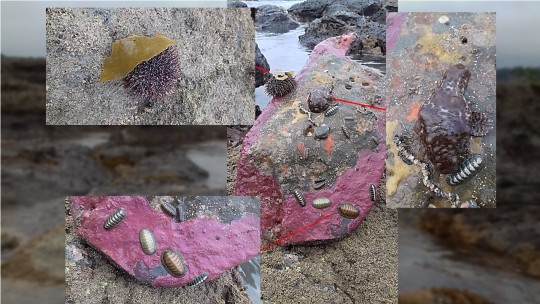
A sea urchin (upper left), a sea cucumber (upper right) and some chitons (below).
In New Zealand, there is a sea urchin called Kina that is actually a fishery resource (I mean, people eat Kina). Before attaching itself to a surface, Kina has a larval phase that lasts 30 days and can travel in the water, so the parents of a Kina larvae could be kilometres away from the place their “baby” will live. Because of these features, it was expected that Kina could travel from the North Island to the South Island of New Zealand, but researchers discovered that Kina larvae might not be able to do that!
You might be wondering how researchers tracked larvae in the sea… As this would be quite hard to do, researchers actually compared genes of Kina living in the North Island and South Island, because if the larvae were travelling between Islands, they would carry the genes of their original population to other populations and all Kina would have similar genes in New Zealand. In the end, there were differences in the Kina genes from North Island and South Island, which leads to conclude that Kina larvae do not travel so well… This elegant research is published:
Nagel, M. M., Sewell, M. A., & Lavery, S. D. (2015). Differences in population connectivity of a benthic marine invertebrate Evechinus chloroticus (Echinodermata: Echinoidea) across large and small spatial scales. Conservation Genetics, 16(4), 965-978. 10.1007/s10592-015-0716-2
Would you be able to say why it is important to know these things? Would it change anything in life? And why would someone even bother designing an experiment to assess such things? Post your answer at the www.seasciencing.tumblr.com! I will follow this up next week!
Sea you soon!
__________________
Kina e seus planos de viagem
Olá pessoal marítmo!
Numa tarde chuvosa de domingo, o mar me presenteou com uma maré muito baixa, mais baixa do que eu normalmente vejo aqui. Preciso dizer que fui para a praia? Um domingo chuvoso, mas um lugar maravilhoso e animais fantásticos!
Quando a maré fica baixa assim e você está em um costão rochoso que forma pequenas piscinas entre as rochas, você conseguirá encontrar mais animais do que normalmente (principalmente aqueles que costumam estar sempre cobertos por água). No meu caso, tive a sorte de encontrar um pepino-do-mar pela primeira vez aqui! E também muitos, muitos ouriços. E, acreditem, eles estão no mesmo grupo que as estrelas-do-mar, bolachas-da-praia e lírios-do-mar, o filo Echinodermata. Vale a pena separar a palavra: Echino significa espinhos e demata significa pele, então estes são os animais que geralmente têm espinhos (ou estruturas parecidas com espinhos) revestindo o corpo.

Piscinas entre as rochas, Mathesons Bay, Nova Zelândia.

Um ouriço (canto superior esquerdo, um pepino-do-mar (canto superior esquerdo) e alguns chitons (parte inferior).
Na Nova Zelândia, há um ouriço chamado Kina que na verdade é um recurso pesqueiro (quero dizer, as pessoas comem Kina). Antes de se fixar a uma superfície, o Kina tem uma fase larval que dura 30 dias e pode viajar na água, então os pais de uma larva Kina podem estar quilômetros de distância de onde seu "filhote" vai viver. Por isso, era esperado que as larvas dos Kinas pudessem viajar da Ilha Norte à Ilha Sul da Nova Zelândia, mas os pesquisadores descobriram que as larvas de Kina podem não conseguir fazer isso!
Você deve estar se perguntando como os pesquisadores rastrearam larvas no mar... Isso seria muito difícil de fazer, então os pesquisadores compararam genes de Kina da Ilha Norte com genes de Kina da Ilha Sul, porque se as larvas Kina viajassem entre as Ilhas, elas carregariam genes de sua população original para outras populações e todos os genes de Kina seriam similares na Nova Zelândia. No fim, os pesquisadores encontraram diferenças nos genes de Kina da Ilha Norte e da Ilha Sul, o que leva a concluir que as larvas Kina não viajam tão bem assim... Esta elegante pesquisa está publicada:
Nagel, M. M., Sewell, M. A., & Lavery, S. D. (2015). Differences in population connectivity of a benthic marine invertebrate Evechinus chloroticus (Echinodermata: Echinoidea) across large and small spatial scales. Conservation Genetics, 16(4), 965-978. 10.1007/s10592-015-0716-2
Você consegueria dizer por que é importante saber essas coisas? Será que isso mudaria algo na vida? E por que alguém perderia tempo para pensar em um experimento para avaliar essas coisas? Poste sua resposta no www.seasciencing.tumblr.com! Vou continuar esse assunto na próxima semana!
Até Mar!
0 notes
Text
Where to find...
Hi sea folks!
In New Zealand, we are starting to feel the summer going away...have you got the chance to turn some rocks over at the beach this summer? Hurry up! Many species reproduce when the water is warmer and you can find a lot of interesting animals, eggs and small juveniles that recently settled on the rocks. But you have to search at the right place.
There are roughly three zones in a rocky shore: Subtidal (covered by water even during low tides), Intertidal (just covered by water during high tides) and supratidal (virtually never covered by water, just receiving occasionally splashes). The animals that live in each of these zones are generally different! So, if you want to see a specific animal, you have to search at the right zone.
Tip: If it is a subtidal animal, go search when the tide is low. And there are some days that the low tide is lower than usual, and these are the best for seeing subtidal animals (you might need to enter a little bit in the water).
A very low tide period started yesterday in the regions close to Auckland, so take this opportunity to see some nice animals that are usually hard to see! (You can always check the tide table online).
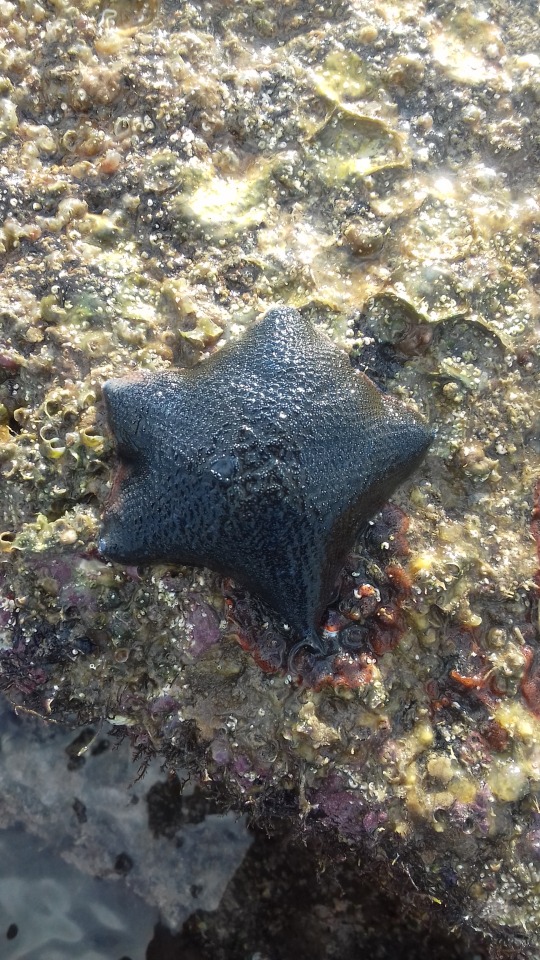
Cushion star (Patriella regularis) - Common in shallow subtidal and low intertidal. Some of them have different colours, like grey, orange, brown and red.
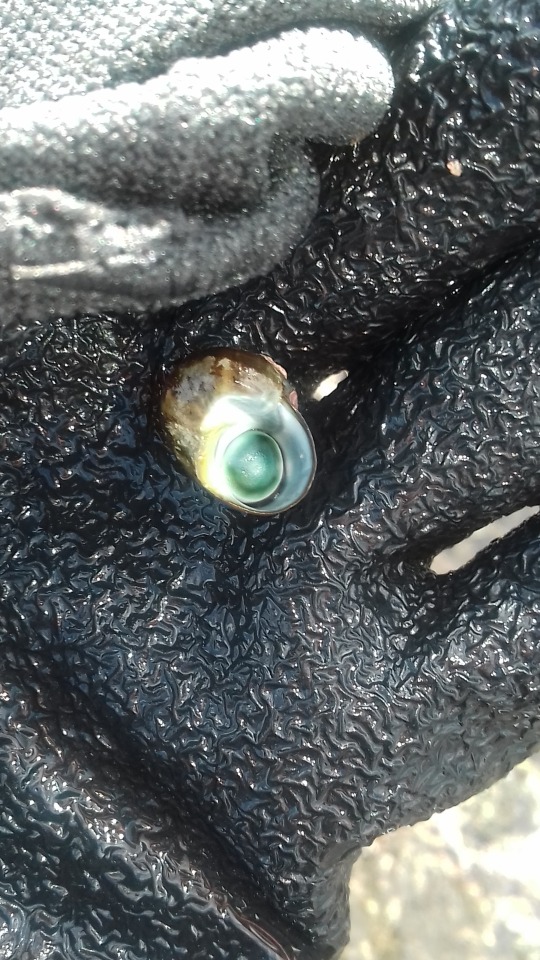
Cats eye (Lunella smaragdus) - Common in mid- to low intertidal. It has a tissue that works like a cover right at the aperture of the shell (called operculum), and this tissue has this beautiful bright colour that resembles the eyes of a cat.

Tree-ring or etched chitons (Onithochiton neglectus) - Common in the subtidal or even deeper down in the sea. Their shells have concentric lines that resembles the ones in a tree trunk, which is why they are called tree-ring chitons.
If you have some nice pictures, share with us! Someone might be able to help you identify the animals if you need (I am learning yet, but I can try).
Sea you soon!
___________________________
ONDE ENCONTRAR...
Olá pessoal marítimo!
Estamos começando a sentir o verão indo embora aqui na Nova Zelândia... você teve chance de virar pedras na praia este verão? Não perca tempo! Muitas espécies se reproduzem quando a água está mais quente e você pode encontrar um monte de animais interessantes, ovos e pequenos juvenis que recentemente se estabeleceram nas rochas. Mas você tem que procurar no lugar certo.
De modo grosseiro, há três zonas em um costão rochoso: Infra Litoral (coberto pela água mesmo durante marés baixas), Meso Litoral ou entre-marés (apenas coberto pela água durante marés altas) e Supra Litoral (quase nunca coberto pela água, recebe apenas alguns borrifos de água). Em geral, os animais que vivem em cada uma dessas zonas são diferentes! Então, se você quiser ver um animal específico, você tem que procurar na zona certa.
Dica: Se for um animal de infra litoral, procure quando a maré estiver baixa. Há alguns dias que a maré fica mais baixa do que o habitual, e estes são os melhores para ver animais de infra litoral (você pode precisar entrar um pouco na água).
Um período de maré muito baixa começou ontem nas regiões perto de Auckland, então aproveite esta oportunidade para ver alguns animais bacanas que geralmente são difíceis de achar! Você sempre pode checar a tábua de marés online. (No Brasil, perto de São Sebastião, há vários períodos de maré bem baixa. Aproveite!)

Estrela do mar almofadada (Patriella regularis) - Comum em infra litoral raso e baixo meso litoral. Algumas têm cores diferentes, como cinza, laranja, marrom e vermelho.
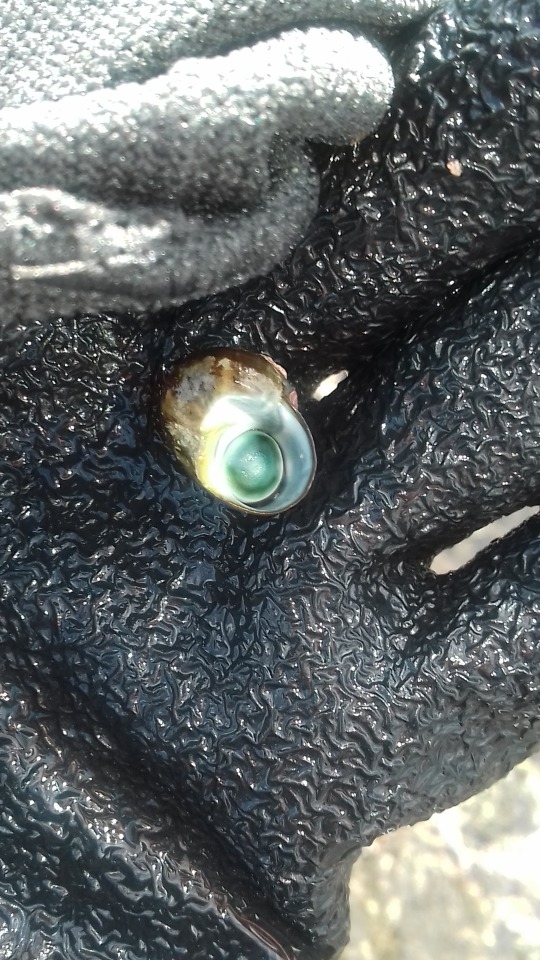
Olhos de gato (Lunella smaragdus) - Comum em médio a baixo meso litoral. Ela tem um tecido que funciona como uma tampa bem na abertura da concha (chamado opérculo), e é este tecido que tem esta cor brilhante que se assemelha aos olhos de um gato.
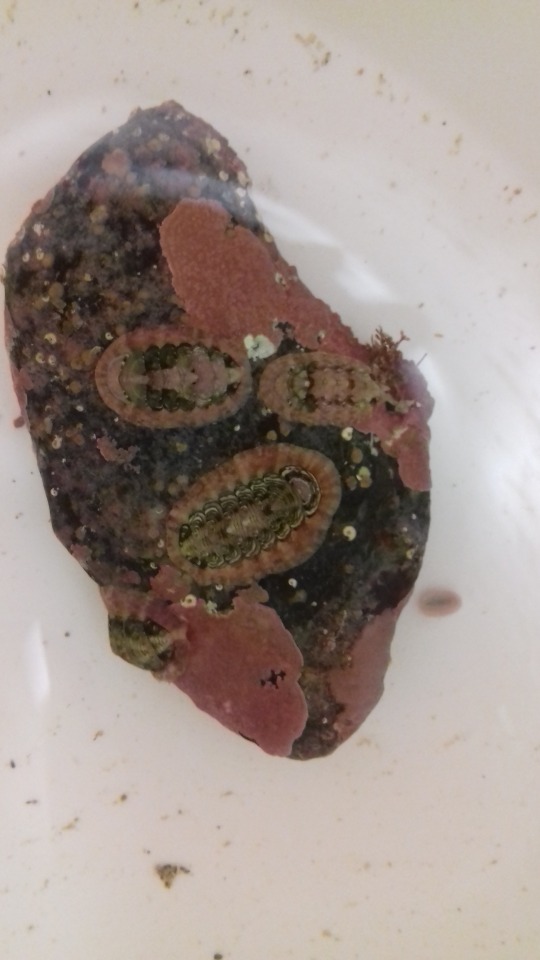
Chitons de anel de árvore (Onithochiton neglectus) - Comum no infra litoral ou mesmo mais profundamente no mar. Suas conchas têm linhas concêntricas que se assemelham às linhas de um tronco de árvore, por isso são chamados chitons de anel de árvore.
Se você tiver fotos bacanas, compartilhe conosco! Alguém pode ajudá-lo a identificar os animais se você precisar (eu estou aprendendo ainda, mas posso tentar).
Até mar!
0 notes
Video
tumblr
Hello Sea Folks!
This week I just want to share a video with you. Please, forgive my lack of filming skills, I am still not as good with cameras as what I was filming deserves. I did this video last week, during another field trip. This time I went to Milford Beach, in Auckland. It is a beautiful beach in a nice neighbourhood (picture below, after text in Portuguese). While I was turning rocks over and searching for a certain species of chiton, I spotted one of those huge black limpets and tried to make it show a little bit of its shell. This one was very shy and I was careful not to harm it. Check out the video above. This limped is called Shield limpet (or duck`s bill limpet, or even elephant limpet). Its scientific name is Scutus breviculus, a mollusc.
I hope you enjoyed!
Sea you soon!
______________________________________________________________
Olá pessoal marítimo!
Esta semana eu só quero compartilhar um vídeo com vocês. Por favor, perdoe minha falta de habilidade com a câmera, eu ainda não sei filmar tão bem quanto o que eu estava filmando merecia. Eu fiz este vídeo na semana passada, durante outra viagem de campo. Desta vez eu fui a Milford Beach, em Auckland. É uma bela praia em um bairro bem bacana (foto abaixo). Enquanto eu estava virando rochas e procurando um certo chiton, eu vi uma daquelas enormes lapas e tentei fazê-la mostrar um pouco da sua concha. Ela era bem tímida e eu estava tomando cuidado para não machucá-la. Confira o vídeo acima (antes do texto em inglês). Essas lapas são chamadas de “lapas-escudo” (ou lapas-bico-de-pato, ou mesmo lapas-elefante). O nome científico é Scutus breviculus, um molusco.
Espero que você tenha gostado.
Até Mar!
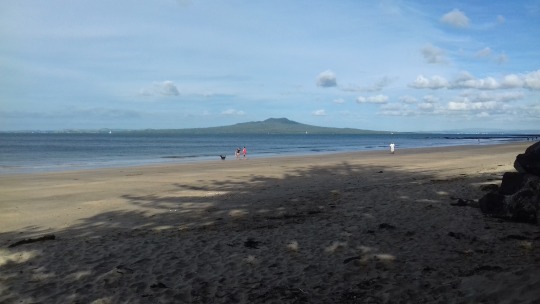
Milford Beach at a Saturday afternoon, Auckland, New Zealand. / Milford Beach em uma tarde de sábado. Auckland, Nova Zelândia.
0 notes
Text
Answering time!
Were you sailing at the right direction about the question of the last post? What is that orange animal in a rock?

Notoplax violacea or violet chiton.
Can you see eight shells at its back? Yes, it is a chiton! In this chiton, the part that surrounds the eight shells grows a lot and is very fleshy, while the eight shells are reduced. And it is not poisonous, even having such a strong colour that makes you feel like it is warning you not to touch it. I wonder why it has this colour… it is almost like it is waving its location and wanting to be a very tasty breakfast to some other animal, unless its predators cannot see…
______________________________________________________________
Hora da resposta!
Será que você estava navegando na direção certa sobre a pergunta do último post? O que é aquele animal laranja?

Notoplax violacea ou chiton violeta.
Você consegue ver oito conchas em suas costas? Sim, é um chiton! Neste chiton, a parte que rodeia as oito conchas cresce muito e é bem carnuda, enquanto as oito conchas são reduzidas. E ele não é venenoso, mesmo tendo uma cor tão forte que faz você achar que ele deve estar te avisando para não tocá-lo. Eu me pergunto por que ele tem essa cor... é quase como se ele estivesse acenando onde está e querendo ser um belo café da manhã para algum outro animal, a menos que seus predadores não podem ver...
0 notes
Text
A huge swimming pool?
Hello Sea Fellows!
This week`s post is about the sea (oh really? And what are the news? You are going to see��)
Some decades ago, scientists would say that everything in the ocean was linked and that there were no boundaries to the animals and larvae swimming in it, as if it were one huge swimming pool. But if this were true, how would you explain that many animals only exist in a restricted place? Why there are no New Zealand green shell mussels in Antarctica? Why Brazilian Namorado Sandperch only exists in Brazil? And I am pretty sure we can come up with an endless list of examples like these two. In reality, can you think of a species that is found in every single corner of the world? I can only come up with the one that wears clothes and builds houses with air conditioning and central heating.

Figure 1: Distribution map of Namorado Sandperch, a photo and a dish. These images are not mine and the sources are in the end of the post.
Another question is that the sea has a huge biodiversity (a huge diversity of living beings) and if it were made up of a single and equal habitat, how such a diversity of life would have evolved? Animals from everywhere would have nothing preventing them from meeting and mating, and all animals would be close relatives! This means that they would all be very similar, which is not true, as you can see for yourself every time you turn a rock over and find so many different life forms.
All this thinking leads us to one possible answer: the sea is not a huge swimming pool. And it is actually made up of so many different habitats that you find species like the New Zealand green shell mussel and the Brazilian Namorado Sandperch living in restricted places, either because they are used to the conditions in their habitat and may not stand swimming far from it, or because there is a physical barrier that prevents them from swimming away (in the case of the mussel, the larva are responsible for this “swimming”, or simply for drifting in the water).

Figure 2: Distribution map of Green Shell Mussel of New Zealand, a dish and a photo. These images are not mine and the sources are in the end of the post.
And what is a physical barrier in the sea? One example are water currents, which can create boundaries in the ocean separating species and even groups of the same species. These groups will not be able to interact and will possibly adapt to the unique conditions of their habitats after some thousands or millions of years. If groups of the same species are isolated for long enough, they can accumulate so many differences that they become two different species.
All this thinking is pretty basic and the big blue sea is much more complex than that, as you will end up discovering by yourself if you start trying to explain the distribution of any species. This is what many scientists do (including me!!), and hardly an explanation is exactly the same for more than one species, but it is usually possible to find things in common among them. And what they have in common is the important part, as it helps to make good plans to preserve biodiversity and to explore the species we eat in a responsible way, making sure that the ecosystem is healthy and the resources we need will not end up extinct.
Do you have a story to tell about the distribution of a species? Please, feel free to share with us at the www.seasciencing.tumblr.com.
Sea you soon!
Sources of images:
1. Namorado sandperch: http://www.portaldosanimais.com.br/informacoes/caracteristicas-do-peixe-namorado/ , access in 18 March 2017 2. Green Shell Mussel: http://www.mollusca.co.nz/speciesdetail.php?speciesid=2252&species=Perna%20canaliculus#prettyPhoto , access in 18 March 2017 3. Namorado dish: http://www.tudogostoso.com.br/receita/903-namorado-a-brasileira.html , access in 18 March 2017 4. Green shell mussel dish: http://www.stuff.co.nz/nelson-mail/lifestyle-entertainment/lifestyle/at-the-table/4263097/Marvellous-mussels , access in 18 March 2017 5. Namorado distribution map: Computer generated distribution maps for Pseudopercis numida (Namorado sandperch), with modelled year 2100 native range map based on IPCC A2 emissions scenario. www.aquamaps.org, version of Aug. 2016. Web. Accessed 18 Mar. 2017. 6. Green Shell Mussel distribution map: AquaMaps - http://eol.org/data_objects/19123770 , access in 18 March 2017
______________________________________________________________
Uma enorme piscina?
Olá pessoal marítimo!
O post desta semana é sobre o mar (ah, sério? E qual é a novidade? Você verá...)
Algumas décadas atrás, os cientistas diziam que tudo no oceano estava ligado e que não havia limites para os animais e as larvas nadando nele, como se fosse uma enorme piscina. Mas se isso fosse verdade, como você explicaria que muitos animais só existem em um lugar restrito? Por que não há mexilhões verdes da Nova Zelândia na Antártida? Por que o peixe Namorado só existe no Brasil? E eu tenho certeza que podemos fazer uma lista interminável de exemplos como estes dois. Na realidade, você consegue pensar em uma espécie que é encontrada em todo canto do mundo? Eu só consigo pensar em uma que usa roupas e constrói casas com ar condicionado e aquecimento central.
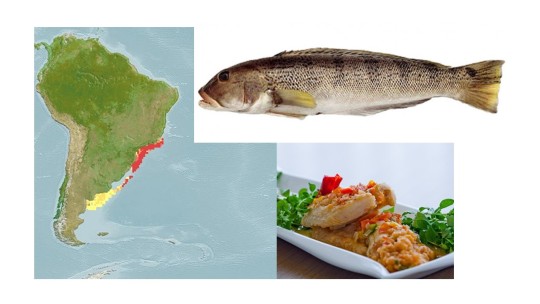
Figura 1: Mapa da distribuiçao do peixe namorado. Essas imagens não são minhas e as fontes estão no final do post.
Outro ponto é que o mar tem uma enorme biodiversidade (uma enorme diversidade de seres vivos) e se ele tivesse só um habitat inteiro parecido, como essa diversidade de vida teria evoluído? Não haveria nada impedindo animais de qualquer lugar a se encontrar e acasalar, e todos os animais seriam parentes próximos! Isso significa que todos eles seriam muito semelhantes, o que não é verdade, como você pode ver por si mesmo toda vez que você vira uma rocha e encontra tantas formas de vida diferentes.
Todo esse pensamento nos leva a uma possível resposta: o mar não é uma enorme piscina. Na verdade, ele é formado por tantos habitats diferentes que você encontrar espécies que vivem em locais restritos, como o mexilhão verde da Nova Zelândia e o peixe Namorado do Brasil, seja porque eles estão acostumados com as condições de seu habitat e morreriam se nadassem para longe, seja porque há uma barreira física que os impede de nadar além dela (no caso do mexilhão, a larva é responsável por “nadar”, ou simplesmente por ser carregada pela água).

Figura 1: Mapa da distribuiçao do mexilhão verde da Nova Zelândia. Essas imagens não são minhas e as fontes estão no final do post.
E o que pode ser uma barreira física no mar? Um exemplo são correntes de água, que podem criar limites no oceano separando espécies e até mesmo grupos da mesma espécie. Estes grupos não serão capazes de interagir e, em alguns milhares ou milhões de anos, possivelmente estarão adaptados às condições únicas de seus habitats. Se grupos da mesma espécie ficarem isolados por tempo suficiente, eles podem acumular tantas diferenças que acabam se tornando duas espécies diferentes.
Todo este pensamento é bem básico e a imensidão azul do mar é muito mais complexa do que isso, como você vai descobrir por si mesmo se você for tentar explicar a distribuição de qualquer espécie. Isso é o que muitos cientistas fazem (inclusive eu!), e dificilmente uma explicação é exatamente a mesma para mais de uma espécie, mas geralmente é possível encontrar coisas em comum entre elas. E o que elas têm em comum é a parte importante, porque ajuda a fazer bons planos para preservar a biodiversidade e explorar as espécies que comemos de forma responsável, com a certeza de que o ecossistema está saudável e os recursos de que necessitamos não serão extintos.
Você tem uma história para contar sobre a distribuição de uma espécie? Sinta-se convidado para compartilhar conosco no www.seasciencing.tumblr.com
Até mar!
Fontes das imagens:
1.Namorado: http://www.portaldosanimais.com.br/informacoes/caracteristicas-do-peixe-namorado/ , acesso em18-03-2017 2. Mexilhão verde da Nova Zelândia: http://www.mollusca.co.nz/speciesdetail.php?speciesid=2252&species=Perna%20canaliculus#prettyPhoto , acesso em 18-03-2017 3. Namorado (prato): http://www.tudogostoso.com.br/receita/903-namorado-a-brasileira.html , acesso em 18-03-2017 4. Mexilhão verde da Nova Zelândia (prato): http://www.stuff.co.nz/nelson-mail/lifestyle-entertainment/lifestyle/at-the-table/4263097/Marvellous-mussels , acesso em 18-03-2017 5. Mapa de distribuição de Namorado: Computer generated distribution maps for Pseudopercis numida (Namorado sandperch), with modelled year 2100 native range map based on IPCC A2 emissions scenario. www.aquamaps.org, version of Aug. 2016. Web. Accessed 18 Mar. 2017. 6. GMapa de distribuição de mexilhão verde da Nova Zelândia: AquaMaps - http://eol.org/data_objects/19123770 , acesso em 18-03-2017
0 notes
Text
Field Trip
Hello Sea Folks!
Did you get the opportunity to enjoy a nice day looking for animals and chilling out at the beach this week? I have got one of those days as part of my work some weeks ago, so I had to go out and explore to find the animals I am working with. This means work at the beach! Which is still work, maybe during a nice sunny Sunday, but it is a very good day out too (this part of my work is the best!)
As it was my first “field trip” (read “work out of the office”), I had no idea of what to expect. I called my field assistant, which seems fancy but actually is any good soul willing to help you work at the beach (in my case, my husband), and went to a very beautiful place to walk on the shore and turn some rocks over – North Head, at Devonport, Auckland.
I had to do a lot of searching to find out where the animals that I work with were previously recorded, mainly using museum databases online, and then my supervisors and I decided to start from a shore nearby, easy to reach without a car. And off I went, with my field-assistant-husband.
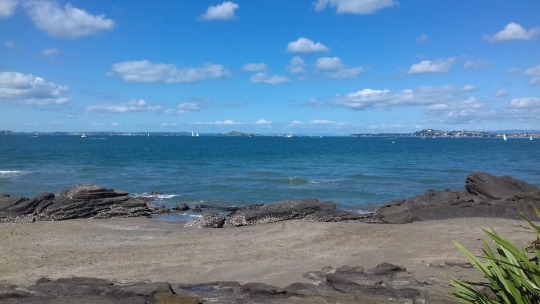
North Head (one of the spots at the track), Devonport, Auckland. #Devonport #Auckland
As this field trip was just to see what we would find and where, we did not wanted to collect any animals and were very careful not to harm them. Sometimes, researchers have to collect the animals they are working with, and it is common that an ethics approval is needed for someone to be allowed to do that, it depends on the animal you are working with and the place you are going to collect. I will have to collect some invertebrates latter (I won`t need ethics approval, but I surely have to be ethical). In my opinion, the main reason for this paperwork is that the ecosystem needs these animals to keep its balance and, believe me, you want the ecosystem very well balanced, so be gentle to it and just take some very nice pictures to show your friends what you saw and post at the www.seasciencing.tumbl.com :)
Enough of writing and making you read. It is my turn to post some pictures! We were looking for under boulder chitons (what?? – see a picture below) and look what fascinating and different animals we have found!
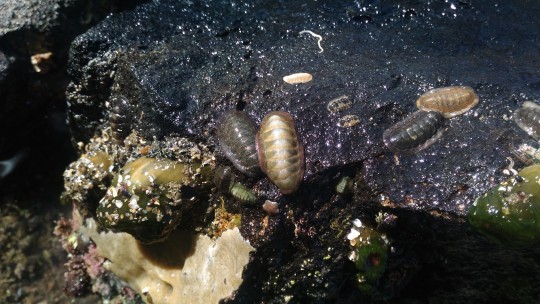
The green things are anemones (like the home of Nemo), the elongated ones are chitons (they are Mollusca, as squids, mussels and whelks, but they have eight plates forming their shell and they roll up like an armadillo!) And I can also see a small sea star just below where the two bigger chiton fellows are.

More sea stars, chitons and a lot of barnacles! Sea stars are Echinodermata, the same phylum of sea urchins. Chitons are Mollusca, as I said above. And barnacles are Arthropoda! Inside each “shell” is a small animal that kind of looks like a shrimp.
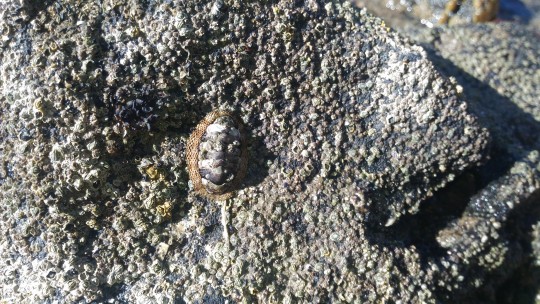
Lots of barnacles, even over this chiton shells! For me, this chiton looks like a Sypharochiton sp, because of the part similar to a snake skin around his eight shell plates, but I am still learning how to identify them.

I bet you tell me what this fantastic orange animal is? Is it poisonous? Leave what you think at the comments, I will answer next week!

What a colourful rock! It might be full of things that I cannot see now, but all these colourful things seem like egg masses to me (some invertebrates lay eggs like this).

Hello little friend! A very small crab, that is of the same phylum as the barnacles! They are all Arthropoda, as spiders and ants!

This ones are surprising! The black one is a limpet that can reach the size of my hand, and it actually has a shell (if you gently touch it, the shell starts to show). At its right there is another chiton! Yes, the one with no shell, it is a butterfly chiton. And there are some periwinkles and algae on this rock, including a green periwinkle almost over the butterfly chiton.
Have you ever seen something similar? Or something surprisingly different? Do you have a picture to share?
Sea you soon!
______________________________________________________________
TRABALHO DE CAMPO
Olá pessoal marítimo!
Você teve chance de passar um dia de diversão na praia essa semana, procurando por animais e esfriando a cabeça? Eu tive um dia desses como parte do meu trabalho algumas semanas atrás, então eu tive que sair e explorar para encontrar os animais com os quais eu trabalho. Isso significa trabalho da praia! O que ainda é trabalho, talvez durante um lindo domingo de sol, mas também é um belo dia de passeio (essa parte do meu trabalho é a melhor!)
Como era o meu primeiro “trabalho de campo” (lê-se “trabalho fora do escritório”), eu não tinha ideia do que esperar. Chamei meu assistente de campo, o que parece chique mas na verdade é só uma boa alma afim de te ajudar a trabalhar na praia (no meu caso, meu marido), e fui para um lugar muito bonito para andar no costão rochoso e virar algumas pedras para cima - North Head, em Devonport, Auckland.
Eu tive que procurar bastante para descobrir onde os animais que eu trabalho já foram vistos, principalmente usando base de dados de museus na internet, e depois meus orientadores e eu decidimos começar em um costão próximo, fácil de chegar sem um carro. E lá fui eu, com meu assistente-de-campo-marido.

North Head (uma das partes da trilha), Devonport, Auckland.
Como esse trabalho de campo foi só para ver o que e onde nós iríamos encontrar, nós não quisemos coletar nenhum animal e fomos bem cuidadosos para nao machucá-los. Às vezes pesquisadores tem que coletar os animas que eles trabalham, e é comum precisar de uma licensa ética para poder coletar legalmente, depende do animal que você trabalha e do lugar que você vai coletar. Eu vou coletar alguns invertebrados mais para frente (não vou precisar de licensa, mas com certeza terei de ser ética). Na minha opinião, o maior motivo para essa burocracia é que o ecossitema precisa desses animais para se manter em equilíbrio e, acredite, você quer que o ecossistema fique bem equilibrado, então seja gentil com ele e apenas tire algumas fotos bem bacanas para mostrar o que você viu aos seus amigos e postar no www.seasciencing.tumbl.com :)
Chega de escrever e te fazer ler. É a minha vez de postar algumas fotos! Nós estávamos procurando por alguns chitons embaixo das rochas (o quê? - veja uma foto abaixo) e olha que animais fascinantes e diferentes nós encontramos!

As coisas verdes são anêmonas (como a casa do Nemo), os que são mais compridos são os chitons (eles são Mollusca, como lulas, mariscos e caracóis, mas eles tem oito placas formando a concha e eles se enrolam igual tatu-bola!) E eu também consigo ver uma pequena estrela-do-mar logo abaixo de onde os dois maiores amigos chitons estão.

Mais estrelas-do-mar, chitons e um monte de cracas! As estrelas do mar são Echinodermata, o mesmo filo dos ouriços. Chitons são Mollusca, como eu disse acima. E as cracas são artrópodes! Dentro de cada “concha” tem um pequeno animal meio parecido com um camarão.

Um monte de cracas, mesmo em cima das conchas desse chiton! Para mim, esse chiton parece um Sypharochiton sp, por causa da parte parecida com uma pele de serpente que ele tem em volta das oito conchas, mas eu ainda estou aprendendo como identificá-los.
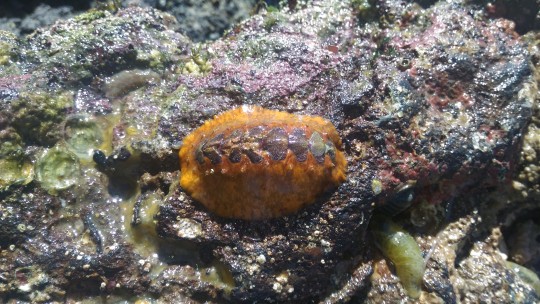
Eu aposto que você me fala o que é esse fantástico animal laranja! Será venenoso? Deixe o que você pensa nos comentários, eu respondo na semana que vem!

Que rocha mais colorida! Ela deve estar cheia de coisas que eu não consigo ver, mas todas essas coisas coloridas parecem massas de ovos para mim (alguns invertebrados botam ovos parecidos).
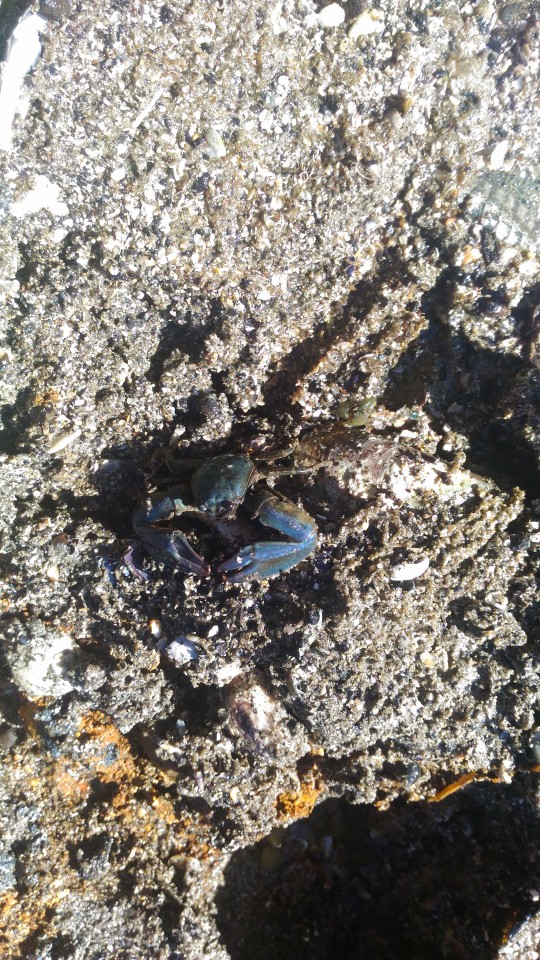
Olá amiguinho! Um carangueijo bem pequeno, que é do mesmo filo que as cracas! Eles são todos Arthropoda, como aranhas e formigas.

Esses são surpreendentes! O preto é uma lapa que pode ficar do tamanho da minha mão, e na verdade ela tem uma concha (se você encostar nela gentilmente, a concha começa a aparecer). À direita dela, tem outro chiton! Sim, o que não tem concha, é um chiton borboleta. E tem alguns caracóis e algas nessa rocha, incluindo um caracol verde quase em cima do chiton borboleta.
Você já viu algo parecido? Ou algo surpreendentemente diferente? Você tem uma foto para compartilhar?
Até mar!
1 note
·
View note
Text
A small wave just to start
Are you amazed by the greatness of the sea? Have you ever wondered why it has such a huge diversity of life forms and how they interact with everything that surrounds them? Are you someone who enjoys going to a beach and take your time turning rocks over, or snorkeling around in some shallow water sanctuary, just to see what fascinating things are there?
I am one of those people, full of curiosity. And I also love science, specifically biology and, more specifically than that, genetics and evolution. So I wanted to dig deeper in all those areas and ended up in a PhD, working as close as possible to the sea and also using genetic tools and evolution theories to try to understand a little bit more about marine life.
When I say that, people think that I work with genetics of whales and dolphins. Or maybe turtles? What about sharks? Nah… I really admire these great animals, as I think you do too, but have you ever looked at the marine invertebrates? This is where I am now. And they are so nice that they convinced me to do this blog, aiming to share what they are teaching me with each curious person fascinated by the sea. And by science. And by life.
In other words, what you will find in the seasiencing.tumblr.com is a Brazilian student that moved to New Zealand to do her PhD and is trying to tell the world what her work is about, because she works with something nice, that you enjoy as much as her (or even more). She hopes to be able to cover topics from finding and identifying some species to more specific information about genetics and evolution in the marine environment, starting with a focus in the beautiful New Zealand (just because it is where she works).
You are more than welcome to share your thoughts, pictures, doubts, concerns and opinions, as long as you are respectful with the other readers and me. Also, I will try to write often, in an engaging way, but I am sorry if I make mistakes - we are all humans ;)
Respect Nature, the sea and the animals you may come to find (and I hope you find loads of them!)
Thanks for reading. Sea you soon!
_____________________________________________________________
Uma pequena onda só para começar
Você se impressiona com a imensidão do mar? Já se perguntou porque a vida no mar é tão diversa e como os diferentes seres interagem com tudo o que os rodeia? Você é uma daquelas pessoas que se diverte quando vai à praia e gasta um tempo virando rochas ou fazendo snorkel em algum santuário de águas rasas, apenas para ver quais coisas fascinantes estão por lá?
Eu sou uma dessas pessoas, cheia de curiosidade. Além disso, eu amo ciência, espeficamente biologia, e mais especificamente, genética e evolução. Como eu queria me aprofundar mais em todas essas áreas, acabei em um doutorado, trabalhando o mais perto possível do mar e usando ferramentas da genética e teorias da evolução para tentar entender um pouquinho mais sobre a vida marinha.
Quando eu digo isso, as pessoas pensam que eu trabalho com genética de baleias e golfinhos. Ou talvez tartarugas? E tubarões? Nah... Eu realmente admiro esses grandes animais, acho que da mesma forma que você, mas você já observou os invertebrados marinhos? É aí que estou atualmente. E eles são tão bacanas que eles me convenceram a fazer este blog, para dividir o que eles estão me ensinando com cada pessoa curiosa e fascinada pelo mar. E pela ciência. E pela vida.
Em outras palavras, o que você vai encontrar no seasciencing.tumblr.com é uma estudante brasileira que se mudou para a Nova Zelândia para fazer doutorado e está tentando dizer ao mundo sobre o que é o trabalho dela, porque ela trabalha com algo banaca que você gosta tanto quanto ela (senão até mais). Ela espera ser capaz de cobrir tópicos desde onde encontrar e como identificar algumas espécies até informações mais específicas sobre genética e evolução no ambiente marinho, começando com foco na linda Nova Zelândia (só porque é lá que ela trabalha).
Você é mais do que bem vindo a dividir seus pensamentos, fotos, preocupações e opiniões, desde que você seja respeitoso com os outros leitores e comigo. Do mais, vou tentar escrever com frequência, de forma envolvente, mas me desculpe se eu cometer alguns erros - somos todos humanos ;)
Respeite a Natureza, o mar e os animais que você venha a encontrar (e eu espero que você encontre muitos deles!)
Obrigada por ler. Até mar!
0 notes